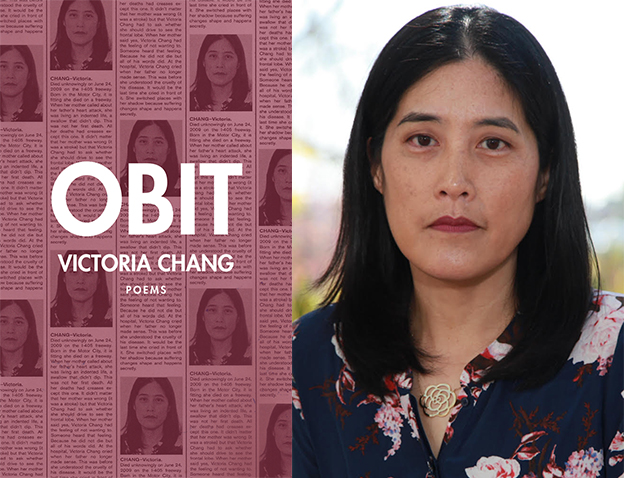A review of 'Obit'

Victoria Chang’s Obit is a book of grief. Yet cutting across its overt autobiographical subject matter, the death of Chang’s mother, the book joins a tradition of apophatic lyricism that runs through Keats, Dickinson, and Ashbery, as well as Chang’s own prior books. (Here’s how she defined love in her previous book, Barbie Chang: “a slow drip without a puddle a faded / paddle on the beach // that the eye cannot see.”[1]) Death is the ultimate object for a secularized apophatic poetics, and Obit anatomizes the unsayability of loss. “Similes — died on August 3, 2015. There was nothing like death, just death. Nothing like grief, just grief.”[2]
Chang develops the newspaper obituary form. In most poems, title and deceased are one and the same. Obit, the book, is built tall and thin, columnar, and so are the text blocks on each page. Obit includes obituaries for “Form,” “Language,” “Similes,” “Subject Matter,” “The Obituary Writer,” and “Victoria Chang,” among others. Grief effaces the self. “In returning out of the tears, the first person I dissolves a little more each time” (93). This quality prevents the book from being simply confessional, since the coherence of the I who speaks is explicitly in question. As in other poetry books of grief, such as Anne Carson’s Nox (New Directions, 2010) and Prageeta Sharma’s Grief Sequence (Wave Books, 2019), Chang favors the prose poem: poetry in mourning dress.
Tankas addressed to (Chang’s) children punctuate the prose poetry. These poems double the generational perspective of the book, a gesture Chang made in Barbie Chang as well. The second section of Obit is a long lineated poem, “I Am a Miner. The Light Burns Blue” (a line of Sylvia Plath’s), and this is the only poem that answers to the back cover’s advertisement of “a stunning lyrical distillation of grief,” for otherwise the book works hard not to distill grief into lyric. Even “I Am a Miner” undercuts itself pointedly: “Everyone wanted poems with an emperor a head / looped inside a rope but this poem is tepid this / poem is no epic” (52). The obituaries, in part because of their prose form and the reference to the conventions of local newspapers, maintain an oppressive awareness of the sleight of hand whereby text supplants experience. “When we remember the dead, at some point, we are remembering the picture, not the moment” (29). True grief is off-page, Keats’s unheard melodies. “At the end of the day, someone took the monitor and speakers away. But the music was still there. This was my first understanding of grief” (34); “here / The pages are turning but no one is reading” (47); “The texts kept interrupting my grief, forcing me to speak about nothing” (70). Chang ends by forswearing closure:
this poem will not end because
I am trying to
end this poem with hope hope hope,
see how the mouth stays open? (105)
These negative lines liquefy poetry into everyday life.
Like Carson and Sharma, Chang attends to what Ben Lerner has called “the incommensurability of elegy and its object.”[3] Traditional (“positive”) elegies, of which the obituary is a nonliterary example, suppress that incommensurability, presenting the text as affirmation and celebration of the absent object. Negative elegies bend their own incommensurability with their object back into themselves, generating a language of self-abnegation and paradox. The distinction isn’t evaluative; it’s formal. Given their subject matter, elegy is the particular form of lyric that Sharma and Chang reject or, which is the same thing, produce negatively. “Elegies ceased being / elegant.”[4] “There must be some way of drawing a picture so that it doesn’t become an elegy” (65). The obituary prose poems in Obit manage their objects in one way, in benumbed reportage, and the tankas in another way, through the conflicted language of a mother who is simultaneously a daughter, but they all fail to be elegies. “Maybe nothing is an elegy” (101). Is this sentence to be construed positively (“maybe nothingness is an elegy”) or negatively (“maybe no thing can be an elegy”)? The ambiguity makes the point. In “Didactic Elegy,” a poem that theorizes the “negative lyric,” Lerner had posed the same question in a different form: “Can any memorial improve on the elegance of absence?”[5] Lerner was speaking of the ruins of the World Trade Center, not a mother, but the problem for poetry is the same. In the negative space surrounding the genre of elegy, Chang conveys the magnitude of loss, not only as personal devastation but as privation from the lyric I who would claim the right to grieve. Entering that broken imaginative space, you see your own name in the obituary column. And that is poetry.
1. Victoria Chang, Barbie Chang (Port Townsend, WA: Copper Canyon Press, 2017), 18.
2. Victoria Chang, Obit: Poems (Port Townsend, WA: Copper Canyon Press, 2020), 92.
3. Ben Lerner, “‘What I cannot say is / Is at the vertex’: Some Working Notes on Failure and the Line,” in A Broken Thing: Poets on the Line, ed. Emily Rosko and Anton Vander Zee (Iowa City: University of Iowa Press, 2011), 146.
4. Prageeta Sharma, Grief Sequence (Seattle: Wave Books, 2019), 55.
5. Ben Lerner, Angle of Yaw (Port Townsend, WA: Copper Canyon Press, 2006), 67.
